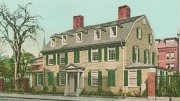Harvard people—faculty members, of course, but also alumni and staff—and others somehow connected to the place are all very conversant with the quill or the keyboard: a lot of books arrive at 7 Ware Street seeking attention. Primus, who wades through the incoming tide, is occasionally struck by the stories that emerge from these volumes, intended or not.
Two recent specimens, both self-published, concern small businesses and retailing—not a category typically represented. The first, The Book of Joie: Or, A Thousand Singing Hamsters, A Micro-Business Memoir, by Linda Given, A.L.B. ’19, is an exceedingly detailed life of the Joie de Vivre gift shop, which operated at 1792 Massachusetts Avenue, toward Porter Square. By its own account, it sold absolutely nothing essential: “wind-up toys, kaleidoscopes, jewelry, flashing rings, clocks, snow globes, music boxes, books, postcards, rubber ducks, singing animals and all kinds of other things designed to enchant, or give pleasure through the unexpected.”
As Given recounts, the work gave her and customers lots of the intended small pleasures. It changed as retailing moved online, trade shows shrank, and shoplifting became more of a problem. When it came time to administer last rites (rather than, say, selling to a successor), she observes, “Joie de Vivre was my creation, my baby.…I felt no one else would be able to keep the spirit of the store the same. I conceived it, opened it, worked early mornings and late nights in it, and had a very particular vision of what was right for it. Had it been doing really well, I probably would have given the staff a good raise, worked less myself, and kept it going for at least a while longer. But it wasn’t doing well.” And so, finis.
The second, Miles, Chet, Ralph, and Charlie: An Oral History of The Andover Shop, edited by Constantine A. Valhouli (with the additional long cover line, “How Charlie Davidson turned a tiny store in Harvard Square into an unlikely literary salon, dressed jazz legends and presidents, helped bring Ivy Style to the mainstream, and occasionally sold some clothing”) is set smack dab in the center of the Square and so makes larger cultural claims for its subject.
In the introduction, G. Bruce Boyer (who was fashion editor for Town & Country, GQ, and Esquire, to give you a sense of things) writes, “The Andover Shop that Charlie confidently steered through the shifting fashions of seven decades wasn’t so much a store as it was a shrine to good taste. And for the luckier few, it was a club. Where else might you find, on a Saturday afternoon, famous novelists [Ralph Ellison] and jazz legends [Miles Davis, Chet Baker], Harvard professors [Henry Louis Gates Jr.] and Supreme Court justices, and perhaps an undergraduate who just wanted a sweater and was oblivious to everything going on around him.”
Unlike Joie de Vivre, the Andover Shop, still on Holyoke Street, has outlived its animating presence (Davidson died in 2019). But the two radically different places had a common trait: their characters reflected their proprietors’ personalities. In that sense, they helped make the extended Harvard Square distinctive: small stores that catered to customers’ interests and crotchets.
In some ways, the passing of such traits matters not. Someone determined to get whimsical doodads can resort to Amazon or Oriental Trading Company (now owned by Berkshire Hathaway!). Preppy style has attenuated, and not every clubbable culture need be lamented.
But in another light, these small transitions loom large. The visitor emerging into Harvard Square from the MBTA Red Line station today encounters a CVS, Starbucks, and bank branches (plus the still-barricaded former Out of Town News, undergoing its multiyear renovation into an unneeded visitor center). Those tenancies reflect high rents, changes in property ownership, the shift toward tourism-focused retailing, and perhaps even Harvard’s own practice of opening eateries within campus properties. Generational change contributes, too: the people who labored away for so many hours and years in their retail enterprises have earned some leisure, and surely their children and friends are free to choose easier work.
Whatever the causes, with the action shifting to Kendall Square and the University’s own institutional and commercial investments in Allston, Harvard Square’s edgy energy has continued to ebb. For all the warm memories these books preserve, their effect is elegiac. —primus vi









